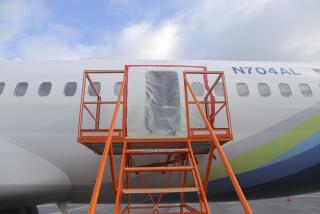Southwest CEO says all but 2 planes will resume flying by Saturday
- Share via
Reporting from Dallas and Los Angeles — A week after a hole ripped open on the fuselage of a Southwest Airlines jet, the carrier’s chief executive, Gary C. Kelly, said that all but two inspected planes would be back in the air by Saturday.
During a panel discussion at a gathering of financial journalists in Dallas on Friday, Kelly said Southwest had inspected and returned to service 78 planes but was still making repairs on two jets, including the Boeing 737 plane with the damaged fuselage.
Southwest canceled more than 600 flights last weekend after a flight from Phoenix to Sacramento suffered a rapid loss of cabin pressure when a hole tore open on the top of the fuselage. Inspections later uncovered cracks in the fuselage of five Southwest planes.
“We are very pleased no one was injured,” Kelley said.
A Federal Aviation Administration official said an investigation into the cause of the incident had yet to be completed.
At the Dallas conference, Kelly also said he expected Southwest to continue to order planes from Boeing Co., the manufacturer of the 737-300 that was damaged during the flight to Sacramento.
The incident involved a 15-year-old 737 that had completed almost 40,000 takeoff-and-landing cycles. The plane averaged more than seven cycles a day. The rupture took place at a lap joint, where two sections of the plane’s aluminum outer skin meet and are riveted to the frame.
After the incident, the FAA ordered airlines to enhance and increase the frequency of inspections for older, heavily used Boeing 737-300s, 400s and 500s after they reach a certain number of flight cycles. But some independent safety engineers say the FAA requirements don’t go far enough and have suggested the airlines inspect every lap joint on all older Boeing 737s.
Responding to suggestions that the airline perform more inspections, Kelly said his airline was following the safety guidelines called for by Boeing and the National Transportation Safety Board.
“It’s not that it takes a long time,” he said of the safety inspections. “We will do whatever it takes to ensure safety, but at a certain point you need to take off.”
More to Read
Inside the business of entertainment
The Wide Shot brings you news, analysis and insights on everything from streaming wars to production — and what it all means for the future.
You may occasionally receive promotional content from the Los Angeles Times.










